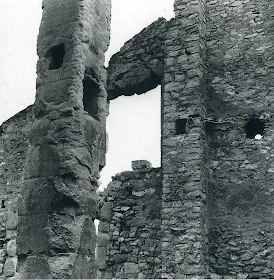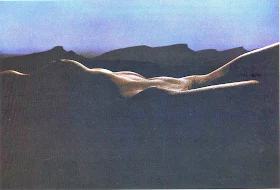Κατολισθήσεις
σε μια παγωμένη πλαγιά στην επιφάνεια του Άρη, Μια λεπτομέρεια από την αρχική
φωτογραφία του HiRISE.
Η
Βόρεια Πολική περιοχή του Άρη καλύπτεται από στρώματα πάγου και σκόνης, που
ονομάζονται "στρωσιγενείς πολικές αποθέσεις". Αυτό το μόνιμο πολικό
κάλυμμα στην διάρκεια του χειμώνα καλύπτεται από ένα επιπλέον, εποχιακό αυτή
την φορά, στρώμα πάγου διοξειδίου του άνθρακα. Όταν ο Ήλιος ανατέλλει την
άνοιξη, οι απότομες πλαγιές αυτών των αποθέσεων είναι αυτές, που θερμαίνονται
πρώτες. Ο πάγος διοξειδίου του άνθρακα εξαχνώνεται (μεταβαίνει κατ΄ευθείαν σε
αέριο, από στερεό) και αποσταθεροποιεί χαλαρά κομμάτια φωλιασμένα στην απότομη
πλαγιά. Υλικά, από τα χαλαρότερα στρώματα αποκόπτονται τότε και κατρακυλούν
στην απότομη πλαγιά. Εδώ, μπορούμε να δούμε μια σκοτεινόχρωμη λωρίδα πλάτους
περίπου ενός χιλιομέτρου, να σηματοδοτεί την πορεία αυτών των χαλαρών υλικών.
Οι εικόνες του HiRISE συχνά έχουν πιάσει κατολισθήσεις την στιγμή που
συμβαίνουν κατά την διάρκεια της άνοιξης, κατά μήκος της άκρης των πολικών
αποθέσεων, σ' αυτή την περιοχή.
The North Polar
region of Mars is capped with layers of water ice and dust, called the
"polar layered deposits." This permanent polar cap is covered in the
winter with a layer of seasonal carbon dioxide ice. When the sun rises in the
spring, the steep edges of the polar layered deposits are the first to warm up.
The dry ice sublimes (going directly from a solid to a gas) and destabilizes
loose chunks perched on the steep cliff. Material from the weaker layers gets
dislodged and cascades down the steep slope. Here, we can see a dark streak
marking the path of that loose material, approximately 1 kilometer wide. HiRISE
images often show avalanches in progress in the springtime along the edge of
the polar layered deposits in this area. HiRISE is one of six instruments on
NASA's Mars Reconnaissance Orbiter.
The University of
Arizona, Tucson, operates the orbiter's HiRISE camera, which was built by Ball
Aerospace & Technologies Corp., Boulder, Colo. NASA's Jet Propulsion
Laboratory, a division of the California Institute of Technology in Pasadena,
manages the Mars Reconnaissance Orbiter Project for the NASA Science Mission
Directorate, Washington. Image credit: NASA/JPL-Caltech/Univ. of Arizona



















































































